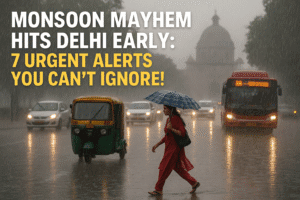Monsoon Mayhem Hits Delhi Early: 7 Urgent Alerts You Can’t Ignore!
Delhi braces for its earliest monsoon arrival in 12 years, with the India Meteorological Department confirming onset on Tuesday (June 24) – a week ahead of the typical June 30 schedule. This mirrors 2013’s early pattern and triggers a “Yellow Alert,” signaling city-wide awareness for thunderstorms and sustained rainfall. Notably, Delhi has already doubled its June average rainfall (89mm vs 43.3mm norm) before the monsoon’s official start, setting a saturated stage.
Residents should anticipate travel disruptions and localized flooding, especially after last year’s record-breaking single-day deluge of 228mm. While promising heat relief, this early surge demands heightened vigilance for commuters and authorities managing drainage. Prepare for continued cloudy skies and rain post-onset as the season intensifies.

Monsoon Mayhem Hits Delhi Early: 7 Urgent Alerts You Can’t Ignore!
Delhiites, dust off those umbrellas and raincoats – the Southwest Monsoon is knocking at the capital’s door significantly ahead of schedule. While the typical arrival date hovers around June 30th, the India Meteorological Department (IMD) forecasts the monsoon’s onset over Delhi on Tuesday, June 24th, triggering a Yellow Alert for the city.
More Than Just Early Rain: Key Insights
- A Notable Shift in Timing: An arrival on June 24th would mark the monsoon’s earliest appearance in Delhi in over a decade. The last time it arrived this early was on June 16th, 2013. This contrasts sharply with recent years:
- 2024: June 28th
- 2023: June 25th
- 2022: June 30th
- 2021: July 13th This early surge suggests favourable large-scale weather patterns pushing the monsoon system northwards faster than usual.
- Yellow Alert: Decoding “Be Aware”: The IMD’s Yellow Alert isn’t a signal for panic, but a crucial heads-up. It means Delhi should expect:
- Widespread light to moderate rainfall throughout Tuesday.
- Potential thunderstorms accompanied by lightning.
- Possible disruption to daily commutes and outdoor activities.
- Localized waterlogging in susceptible areas (think Minto Bridge, underpasses). The alert underscores the need for residents to stay informed about real-time weather updates and plan accordingly.
- A Wet Prelude: June isn’t usually Delhi’s wettest month, but this year has already been unusually damp before the monsoon’s main arrival. With 89 mm of rainfall recorded so far (primarily from pre-monsoon showers), the city has already doubled its normal June rainfall of 43.3 mm – and the main rainy season hasn’t even officially begun! This sets the stage for potentially high seasonal totals if the monsoon remains active.
- Contrasting Last Year’s Deluge: While an early arrival sparks interest, last year serves as a stark reminder of monsoon variability. Although the monsoon arrived slightly later on June 28th, 2024, it unleashed an unprecedented deluge, with Safdarjung recording a staggering 228.1 mm of rain in a single day – nearly the entire normal monsoon quota for June in just 24 hours. This highlights that the intensity of rainfall events can be as impactful as the timing of the onset.
What This Means for You:
- Commute Smart: Anticipate slower traffic, potential waterlogging on key roads, and possible delays in public transport. Allow extra travel time, especially during peak hours on Tuesday.
- Safety First: Be cautious during thunderstorms. Avoid open fields, high ground, standing under trees, or using wired electronics. Seek sturdy shelter if lightning is nearby.
- Home Check: Ensure balcony drains and roof gutters are clear to prevent localized flooding. Secure loose objects outdoors.
- Stay Updated: Keep an eye on official IMD forecasts and local traffic police advisories for real-time information and potential escalation of alerts.
Looking Ahead:
The early monsoon arrival brings the welcome promise of relief from intense summer heat and replenished water reservoirs. However, it also demands heightened awareness and preparedness from Delhi’s residents and civic authorities. The city’s ability to manage this early surge, particularly in preventing urban flooding in vulnerable zones, will be a key test. The IMD predicts generally cloudy skies with continued chances of rain and thunderstorms in the days following the onset, indicating the wet season is truly settling in.
This isn’t just weather news; it’s the cue for Delhi to transition into its monsoon rhythm – a time for chai and pakoras, yes, but also for vigilance and smart planning as the skies open up ahead of the calendar.
You must be logged in to post a comment.